


To see Aida in the Roman Arena in Verona was the driving force for coming to Verona, but the city itself is beautiful, full of history, and a delight to wander around.


Verona is a really beautiful city set inside a loop of the River Adige and has some very fine Roman remains. It has a long history having first become an important settlement under the Romans due to its situation at the crossroads of important north-south and east-west routes.
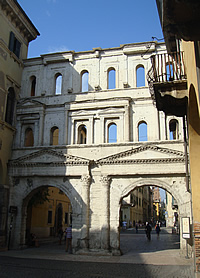






It is also known as the setting for Shakespeare's "Romeo and Juliet" (as well as "Two Gentlemen of Verona" and "The Taming of the Shrew") and has a spurious House of Juliet, complete with the twentieth century addition of a balcony to keep the tourists happy.
We arrived later than anticipated, mainly due to the queues to get through the Gotthard tunnel. We were staying at the Alla Cattedrale guest house - it is very difficult to find good central accommodation when the opera is on at the amphitheatre and we'd perhaps left it a little late to book something. It was OK for a short stay, being at the top of a lovely old Italian building and beautifully furnished, but did not have aircon, only fans, so it wasn't the most comfortable place in the heat of summer.
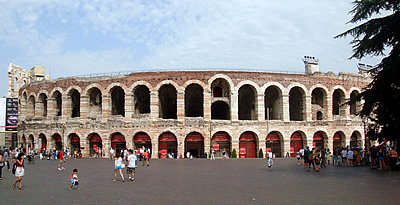
Verona has many magnificent Roman structures, not least the amphitheatre, called the Arena, dating from the first century AD and at 152m by 123m one of the largest Roman amphitheatres ever built. It was damaged in an earthquake in the twelfth century but still retains its basic structure though losing almost all of the arches of its upper surrounding wall. The interior was hardly affected at all by the earthquake and is put to regular use as a venue for spectacular events.







There is also a Roman theatre on the other side of the river and gates, the finest of which is Porta dei Borsari - almost a masterclass in classical architecture on its own. In Roman times it was called Porta Jovia because of the nearby temple to Jupiter, the name change came about in times when it was the principal point of tax collection from travellers entering or leaving the city. In fact what remains is only a facade of the Roman fort which once stood here.
There are bits of Roman sculpture embedded here and there in the walls, including a Gorgon's head on Via Valerio Catullo.
The city declined in importance as the Roman Empire collapsed but rose again, becoming an independent city state in the twelfth century. In this period several fine buildings were erected including the church of San Lorenzo and the Duomo.
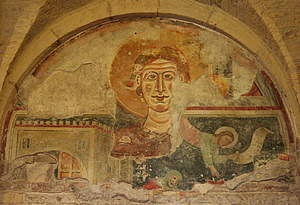
Romanesque San Lorenzo is beautiful, with lovely red brick and cream stone striped walls, typical of this period in Verona. The lower exterior structure dates from the eleventh century, distinguished by herringbone rubble courses between the courses of ashlar blocks and brick, the upper walls have no herringbone courses and are perhaps a century later in date ("Building across the Sacred Landscape: The Romanesque Churches of Verona in their Urban Context", Meredith Fluke, Columbia University, 2012; PDF, opens in a new tab)

This basilica still has its women's galleries on the upper level of the west, south and east walls, reached by spiral staircases in the twin round towers. The simple architecture of the nave is very high and quite narrow giving it a very elegant appearance.
The Duomo is another beautiful red and white striped building, mainly Romanesque with Gothic 14th century renovations and a Renaissance tower. It has some lovely naive sculptures, particularly on the south porch, and at the west door a pair of very weathered lions stand guard.

Over the next century Verona was at its peaked, ruled by the ruthless Scaliger dynasty, and many fine buildings and monuments were erected in this period, including the Scaligers own tombs, five fine Gothic memorials in the heart of the city.

The della Scala (ladder) family ruled the city for around a hundred years from the third quarter if the thirteenth century. Cangrande (big dog) was the most celebrated, a warrior under whose rule Verona's territory expanded to include Padua, Treviso and Vicenza.
Cangrande was succeeded by his nephew Mastino (mastiff) II who continued the expansion, taking in Brescia, Parma and Lucca.
His tyrannical son Cangrande II was killed by his own brother Cansignorio (he also killed his other brother Paolo Albino).
Cangrande II was responsible for the building of Castelvecchio and its bridge Ponte Scaligero, both badly damaged in the Second World War but meticulously reconstructed.

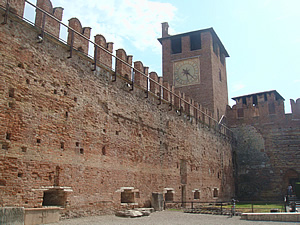
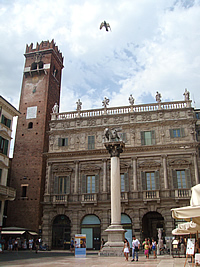

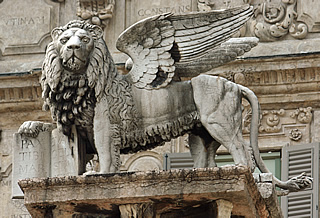
Later Verona was governed by Venice and the winged Lion of St Mark, symbol of Venetian rule, appears around the city, most notably on a column in Piazza del Erbe.
Piazza del Erbe and Piazza dei Signori are the heart of the city. What used to be a vegetable market in Piazza del Erbe now sells mostly stuff for tourists. The piazza is lined with cafes and buildings in a variety of architectural styles and was the site of the original Roman forum, the only tangible remnant of Roman times is the statue on the fountain. It's a great place to take a break from sight-seeing.



At the northern end the baroque Palazzo Maffei is surmounted by six statues of Roman gods: Hercules, Jupiter, Venus, Mercury, Apollo and Minerva. Next door is the 14th century Torre del Gardello, built when, Cansignorio, one of the most powerful of the Scaligers, was Lord of Verona.
Another lovely building is the medieval Domus Mercatorum on the west side of Piazza del Erbe. It was originally the home of the merchants' guild.




On the south-eastern corner of Piazza del Erbe is Arco della Costa leading into Piazza degli Signori. Rising above the arch is the Torre dei Lamberti at the corner of the old town hall, the 12th/13th century Palazzo del Comune (also known as Palazzo della Ragione). Towers symbolised wealth and were routinely built into residences in medieval times this one is the tallest remaining in Verona. Suspended from Arco della Costa (Coast) hangs the rib of a whale - apparently it's been there for centuries.

Through Arco del Costa into Piazza dei Signori on the right side is the beautiful Romanesque facade of the Palazzo del Comune. Entering through the arch leads to the ancient market place in the enclosed courtyard of the palazzo, to one side is the lovely fifteenth century gothic staircase Scala dalla Ragione ("reason" stairs), so called because it led up to the law courts which were once here.
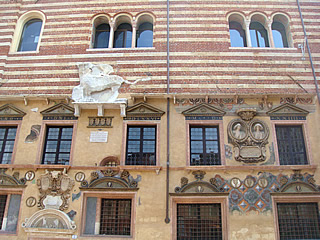

Piazza dei Signori was once the main public square of the city and is its most beautiful. Alongside the Palazzo del Comune is the Palazzo del Capitano, residence of one of the Venetian nobles sent to rule the city.
Opposite is the beautiful Renaissance Loggia del Consiglio - meeting place for the town council. Many of the buildings in the square are now occupied by administrative offices for the city and region. The six statues on top of the Loggia are Roman noblemen including Pliny the elder and the poet Catallus who was born in Verona.



At right angles to the Loggia is the 14th century Palazzo degli Scaglieri from where the family ruled the city - their most famous member Cangrande lived here. A keen patron of the arts he gave refuge to Dante when he was exiled from Florence, hence the statue in the piazza. Above the entrance to the palazzo is another winged lion of St Mark.
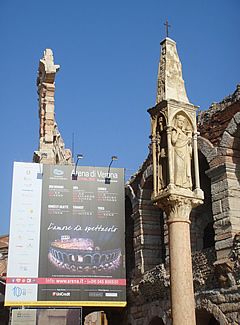
Santa Anastasia is Verona's largest church but a long way from being its most attractive. The very plain exterior is relieved only by some lovely 14th century stone carving around the main entrance.


Our primary reason for coming to Verona was to see Aida at the Arena. The weather was perfect, a very hot day, clear skies and no need for a jacket in the evening, even though the performance didn't start until 9pm and went on until 1 a.m. when it was still warm.
We had a really nice meal and excellent prosecco in a bistro off the beaten track, no tourists only the local Saturday night crowd.
The top back section of the Arena fills early and fast. This is where the unreserved seats are and for which people queue for a couple of hours. We'd taken the precaution of making reservations - more expensive but worth it to choose your place and not have to queue. We took cushions with us as the ranks of stone seats are unforgivingly solid.
Just before the start of the opera everyone lights the candle they had been given on entry and it was a beautiful sight.
Placido Domingo was the conductor for this performance, the first of two he did here of Aida on the weekend. I hadn't realised he was a celebrated conductor as well as being one of the great tenors.
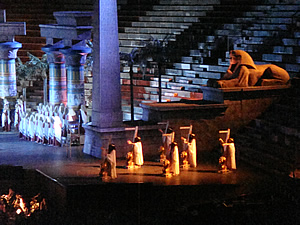


The performance was magical, especially the triumphal entry into Thebes in the second act. Soldiers carrying torches climbed the steps behind the stage and lined up all along the top of the wall

I absolutely loved it, though the long intervals were a bit tedious! As the crowds left the Arena everyone looked happy.

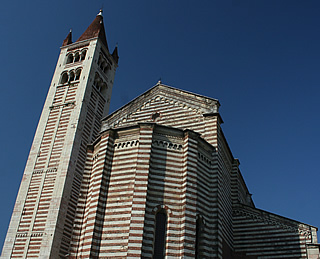
The following day was gloriously sunny with clear blue skies. After a short time meandering to the cathedral we left in order to visit San Zeno before going on to Bergamo.


San Zeno is one of the most significant Romanesque churches in Italy and the model for all other Romanesque churches in Verona. It lies just outside the city to the west and satnav helped us to find it but we ended up at the east rather than west side! We will have to return to see the celebrated doors on the west facade and the interior - it being Sunday morning it was closed to visitors.
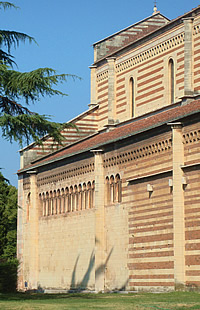

The basilica is constructed of alternating courses of red brick and pale stone - beautiful. The bell tower, begun in 1045, is topped with a conical roof - something we'd noticed in other churches in Verona.
Travelling to Bergamo from Verona we took quite a detour to go through the Valpolicella wine region north west of the city before turning south along the east shore of Lake Garda and joining the motorway to Bergamo.

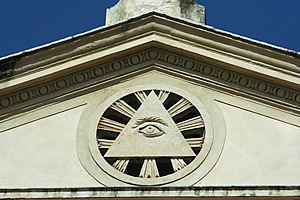
We stopped off at Negrar, a small town which was taken by the Scaliger dynasty in the 14th century and then ruled by Venice, hence the lion of St Mark on its column in front of the church.

Though the church tower is Romanesque nothing remains of the original Romanesque church. The building which stands here today is a nineteenth century construction. On the pediment of the church is a carving of the all-seeing eye of God: an eye in a triangle surrounded by sun rays - it looks quite creepy and as if it is really watching.

We carried on to Fumane then via a fine switchback road through Mazuregga up and over the ridge, through the vineyards, to drop down to the west. As we approached the coast the traffic built up, fortunately most of it heading north to the lakeside and probably lunch!